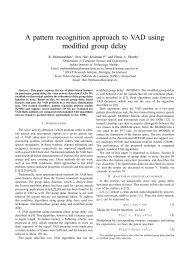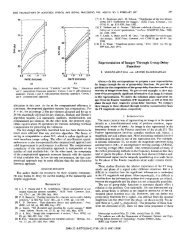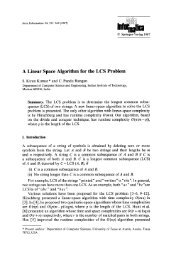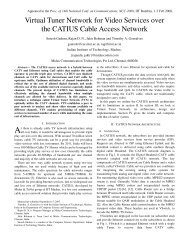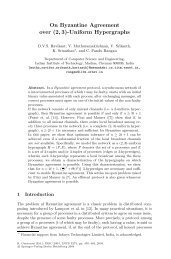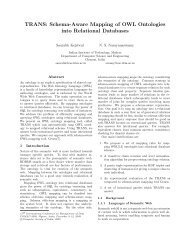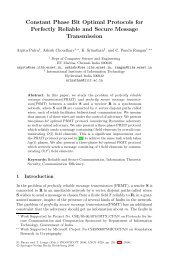Part Of Speech Tagging and Chunking with HMM and CRF - LTRC
Part Of Speech Tagging and Chunking with HMM and CRF - LTRC
Part Of Speech Tagging and Chunking with HMM and CRF - LTRC
Create successful ePaper yourself
Turn your PDF publications into a flip-book with our unique Google optimized e-Paper software.
2003). Let Y denote the chunk label sequence <strong>and</strong>X denote the corresponding observation sequence.A linear chain <strong>CRF</strong> (Lafferty et al., 2001) modelsthe conditional probability P(Y|X) as∑P(Y|X) =Z 1 exp{∑ k+ ∑ ki λ kf k (y i−1 ,y i , X)∑i µ kg k (y i , X)}The feature set {f, g} used in this work is similarto that used in (Sha <strong>and</strong> Pereira, 2003). Table 2describes the feature set. t i <strong>and</strong> c i is the PoS tag<strong>and</strong> the chunk tag respectively for the word w i .Table 2: Feature set used for the chunkerw i−2 = ww i−1 = ww i = ww i+1 = ww i+2 = ww i−1 = w ′ , w i = ww i+1 = w ′ , w i = wt i−2 = tt i−1 = tt i = tt i+1 = tt i+2 = tt i−1 = t ′ , t i = tt i−2 = t ′ , t i−1 = tt i = t ′ , t i+1 = tt i+1 = t ′ , t i+2 = tt i−2 = t ′′ , t i−1 = t ′ , t i = tt i−1 = t ′′ , t i = t ′ , t i+1 = tt i = t ′′ , t i+1 = t ′ , t i+2 = tc i−1 = cTable 3: <strong>Part</strong> of <strong>Speech</strong> tagging resultsModel Precision Recall F β=1<strong>CRF</strong> 69.40 69.40 69.40TnT 78.94 78.94 78.94TnT+TBL 80.74 80.74 80.744 Experiments <strong>and</strong> ResultsWe use the limited category dataset supplied forthe NLPAI shared task 2 for training our PoS tagger<strong>and</strong> chunker. This is referred as the “trainingdata” unless explicitly stated otherwise. We reportthe precision, recall <strong>and</strong> F1 scores for each of2 http://ltrc.iiit.net/nlpai contest06/Table 4: <strong>Part</strong> <strong>Of</strong> <strong>Speech</strong> tagging <strong>with</strong> error correctionPrecision Recall F β=1CC 95.54% 88.13% 91.69INTF 41.67% 100.00% 58.82JJ 46.63% 56.85% 51.23JVB 54.72% 38.67% 45.31NEG 97.83% 80.36% 88.24NLOC 74.47% 71.43% 72.92NN 70.79% 82.85% 76.35NNC 18.89% 19.10% 18.99NNP 62.99% 30.53% 41.13NNPC 46.34% 19.39% 27.34NVB 40.20% 45.05% 42.49PREP 95.91% 95.43% 95.67PRP 91.09% 96.35% 93.65QF 82.14% 70.77% 76.03QFN 87.96% 93.14% 90.48QW 89.47% 100.00% 94.44RB 63.38% 72.58% 67.67RBVB 0.00% 0.00% 0.00RP 86.45% 93.71% 89.93SYM 99.07% 98.53% 98.80UH 100.00% 100.00% 100.00VAUX 90.62% 87.09% 88.82VFM 82.21% 83.14% 82.67VJJ 25.00% 6.67% 10.53VNN 75.61% 88.57% 81.58VRB 79.41% 87.10% 83.08VV 0.00% 0.00% 0.00Overall 80.74% 80.74% 80.74these tasks on the testing set. The reported resultswere derived from a modified CONLL evaluationscript 3 for the same task.4.1 <strong>Part</strong> of <strong>Speech</strong> <strong>Tagging</strong>We tried the <strong>Part</strong> of <strong>Speech</strong> tagging task usingConditional R<strong>and</strong>om Fields (<strong>CRF</strong>s) (Lafferty etal., 2001) using w i−1 , w i−1 w i , w i+1 , <strong>and</strong> w i w i+1as features for the current word w i . In addition to<strong>CRF</strong>s we also tried Brant’s TnT tagger that usesHidden Markov Models (<strong>HMM</strong>). From Table 3 itis clear that TnT outperforms <strong>CRF</strong> in the currentPoS tagging task. This is probably due to the largenumber of output labels for the task (26 PoS tags)<strong>and</strong> relatively small amount of training data.<strong>Part</strong> of <strong>Speech</strong> tagging for the final system wasperformed as follows. First we split the training3 http://www.cnts.ua.ac.be/conll2000/chunking/conlleval.txt



